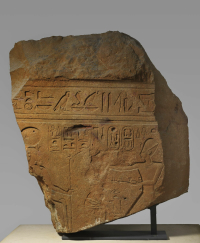



cardboard envelope
An item at Louvre
woman (shroud, tripartite wig, forehead band, usekh necklace, pectoral) Decoration: on the head; solar disk with uraeus; scarab (holding, Chen sign, flanked by); sign of the West; sign of the East in front; on the chest; Maat (crouching, shroud, holding, ostrich feather, in front); nebrid; ram-headed bird (solar disk, wings outstretched, holding, Chen sign) on the belly; Osiris (2, symmetrical, standing, shroud, white crown, holding, was scepter, in front); the four sons of Horus (standing, shroud); sign of the West (2) on the legs; 1st register; falcon (wings outstretched, solar disk, holding, Chen sign); 2nd register; Isis (right, winged goddess, standing, solar disk, protecting); Nephthys (left, winged goddess, standing, sun disk, sign of Nephthys, protecting); 3rd register; kite (2, on, sign of gold, wings spread, protecting) on feet; dog (lying) on base; frieze of prophylactic signs behind; 1st register; djed pillar (crown of Taténen, flanked by); monkey-headed god (2, symmetrical, shroud, kneeling, holding knife); monkey-headed god (2, symmetrical, shroud, kneeling, on, sign of gold, holding knife); 2nd register; divinity (standing, double ostrich feather, sun disk, flanked by); Upper Egyptian lotus (double upright feather, necklace counterweight, on, Chen sign); Lower Egyptian papyrus (double upright feather, necklace counterweight, on, Chen sign); emblem of Nefertum (?); 3rd register; Isis knot (equipped with, head, disc-shaped horns, flanked by); crocodile-headed god (2, standing, symmetrical, shroud, holding, knife)
Department of Egyptian Antiquities
An exhibit at Louvre
The collections of the Department of Egyptian Antiquities present the civilization that evolved on the banks of the Nile, from the end of Prehistory (around 4,000 BCE) to the Christian era (from the 4th century CE).




